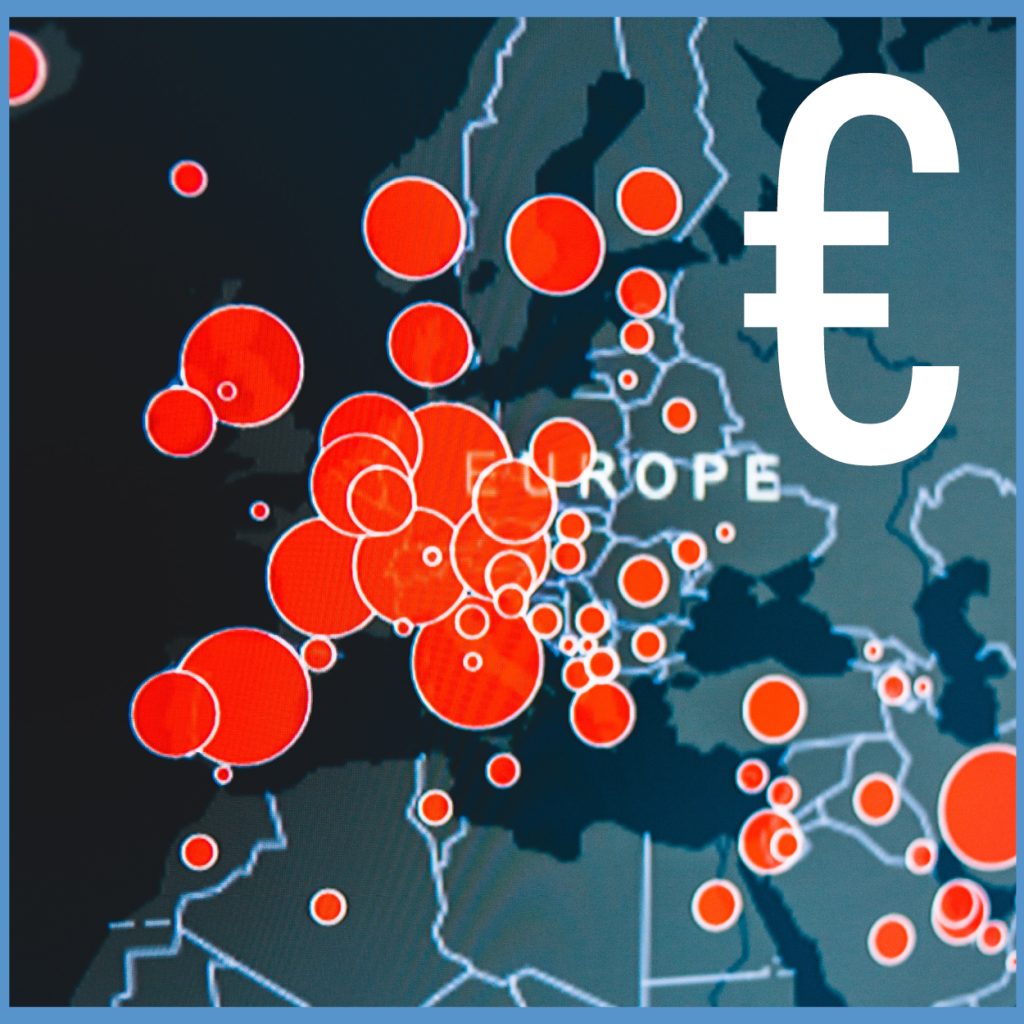Comment le budget de l’UE peut-il contribuer
à résoudre la crise du coronavirus ?
Par Eulalia Rubio, chercheuse senior, Institut Jacques Delors
Traduction de l’anglais par Lucie Duchêne.

La propagation du COVID-19 en Europe induit le besoin d’apporter une réponse financière européenne coordonnée afin de soutenir le système de santé des États membres et d’éviter une récession économique majeure. Compte tenu de sa petite taille, de sa rigidité et d’autres facteurs, comme le fait qu’il ne peut pas être financé par des déficits, le budget de l’UE n’est pas adapté pour répondre à la crise du coronavirus. Néanmoins, il est le seul instrument financier dont disposent les institutions européennes et devrait donc être mis à profit autant que possible pour lutter contre cette crise.
Vendredi 13 mars, la Commission a présenté plusieurs initiatives visant à faire face à l’épidémie de COVID-19. Elle a notamment suggéré la mise au point d’une « Initiative d’investissement en réponse au Coronavirus » d’un montant de 37 milliards d’euros financée grâce aux fonds alloués à la politique de cohésion de l’UE. Le présent blogpost porte sur l’« Initiative d’investissement en réponse au Coronavirus » et examine les autres façons dont le budget de l’UE pourrait être mobilisé pour faire face à la crise. Il émet également quelques remarques générales quant aux répercussions qu’une telle crise pourrait avoir sur la négociation du budget européen 2021-2027.
L’« Initiative d’investissement en réponse au Coronavirus »
L’Initiative d’investissement en réponse au Coronavirus regroupe plusieurs mesures qui visent à faciliter la concentration en début de période et la réorientation des fonds de la politique de cohésion non dépensés au profit de la lutte contre le coronavirus. Ainsi :
- La Commission propose de renoncer à son obligation de réclamer aux États membres le remboursement des préfinancements non dépensés versés au début de l’année. La politique de cohésion de l’UE prévoit en effet le versement de préfinancements, qui correspondent environ à 1-3 % de l’investissement prévu réel. Au titre de la politique de cohésion, si un État membre n’effectue pas toutes les dépenses prévues, il doit rendre les fonds restants à la Commission européenne. Cette dernière leur propose donc de les conserver. En pratique, cela implique de leur octroyer directement des liquidités supplémentaires afin de mettre en place de nouvelles initiatives pour faire face à la crise.
Cette année, le total des fonds avancés non dépensés qui auraient dû être reversés à la Commission atteindrait les 8 milliards d’euros. Au lieu de ça, les États membres devront consacrer cette somme au financement de trois types d’initiatives éligibles pour faire face à la crise : les dépenses de santé liées au coronavirus, le soutien au fonds de roulement des PME et les programmes d’emploi à court terme. Le taux de cofinancement national habituel sera appliqué pour le financement de ces initiatives. Au vu des taux de cofinancement moyens en vigueur dans chaque État membre, la Commission estime que ces 8 milliards d’euros déclencheront le déblocage et la mobilisation de 29 milliards d’euros supplémentaires au sein de l’UE, soit un total de 37 milliards d’euros. - En outre, la Commission suggère de modifier plusieurs clauses de la politique de cohésion de l’UE afin de faciliter la réaffectation des fonds qui lui sont alloués au profit de ces nouvelles priorités et d’apporter un soutien administratif aux autorités de gestion des États membres pour les aider à lancer la préparation et la mise en œuvre de ces nouvelles initiatives dans les plus brefs délais.
Les experts étaient nombreux à juger cette proposition insuffisante. Il lui a été reproché de ne pas impliquer de financement européen supplémentaire et de ne prévoir aucune mutualisation des risques. En effet, la répartition entre les États membres sera déterminée sur la base du montant des préfinancements non dépensé disponible dans chaque pays, et non de critères liés à la gravité de la crise du COVID-19. De ce fait, les premiers bénéficiaires seront la Pologne et la Hongrie, qui ont été jusqu’ici relativement épargnés par l’épidémie.
Ces critiques sont bien fondées, mais la proposition de la Commission présente un avantage non négligeable. Utiliser les programmes existants plutôt que d’en créer de nouveaux à partir de rien garantit le décaissement rapide des fonds européens pour réagir à la crise. De plus, en agissant par le biais de la politique de cohésion de l’UE, la Commission peut s’appuyer sur un système bien organisé pour programmer, mettre en œuvre et superviser l’utilisation des fonds européens selon les besoins locaux.
Finalement, l’« Initiative d’investissement en réponse au Coronavirus » s’apparente aux mesures adoptées en 2008 en réponse à la crise économique et financière mondiale. À l’époque, la Commission avait également suggéré d’intensifier et de faciliter l’utilisation des fonds structurels européens pour accroître les flux financiers à destination des autorités de gestion nationales et régionales[1]. Étant donné que le Cadre financier pluriannuel (CFP) venait de débuter, elle a pu atteindre cet objectif en augmentant les préfinancements pour 2009 plutôt que de permettre aux États membres de conserver les fonds non dépensés. Ainsi, les autorités de gestion nationales et régionale ont pu bénéficier de 6,2 milliards d’euros supplémentaires en 2009, en plus des 5 milliards d’euros déjà octroyés[2]. D’autres initiatives ont été mises en place, comme l’octroi de plus de souplesse pour la réaffectation des dépenses ou l’application des règlements relatifs aux aides d’État. En 2010, une analyse de la Commission démontrait que ces mesures avaient été très bien accueillies par les États membres et qu’elles avaient eu des retombées relativement positives[3].
Enfin, il est important de garder à l’esprit que nous approchons de la fin de la période couverte par le CFP actuel. De ce fait, il est plus difficile de concentrer les fonds européens en début de période. En 2008, en plus de redéfinir les fonds de cohésion de l’UE, la Commission a suggéré de réviser le cadre financier et de déduire 5 milliards d’euros des budgets de 2009 et 2010 afin de les réaffecter au budget de 2008 pour le financement d’infrastructures énergétiques transnationales. Cette stratégie ne peut pas être reproduite aujourd’hui, car nous sommes dans la dernière année du CFP en cours.
Que pouvons-nous faire de plus avec le budget de l’UE actuel ?
Cela ne veut pas dire qu’il n’y a plus rien que l’on puisse faire pour mobiliser davantage de ressources européennes et faire face à la crise. Pour commencer, la Commission a annoncé d’autres initiatives qui viennent compléter celle d’investissement en réponse au Coronavirus.
- Près d’un milliard d’euros supplémentaire sera mobilisé pour soutenir les programmes COSME et InnovFin. Ces deux programmes, mis en œuvre par le Fonds européen d’investissement (FEI), apportent un soutien financier aux PME et aux mid caps. Le FEI offre notamment des garanties aux banques commerciales afin de les aider à octroyer aux entreprises davantage de prêts et de financements par émission d’actions. La Commission estime que grâce à ce milliard d’euros supplémentaire, les banques débourseront 8 milliards d’euros de plus pour soutenir les entreprises. Il est cependant important de préciser que ce milliard d’euros n’est pas de l’« argent frais » : il sera prélevé du montant de la garantie budgétaire de l’UE (EFSI) prévu pour couvrir des projets et d’autres objectifs à plus long terme.
- Le champ d’application du Fonds de solidarité de l’UE (FSUE), qui couvrait à l’origine les catastrophes naturelles, sera révisé pour inclure les crises sanitaires. Les États membres pourront alors demander une aide financière si nécessaire. En 2020, le montant disponible s’élève à 800 millions d’euros.
- La Commission a également exprimé sa volonté de mobiliser si besoin le Fonds européen d’ajustement à la mondialisation (FEM) pour soutenir les travailleurs indépendants et les personnes licenciées touchés par la crise. En 2020, jusqu’à 179 millions d’euros sont disponibles à ces fins.
En outre, il pourrait y avoir d’autres façons de débloquer des fonds européens supplémentaires afin de faire face à la crise du COVID-19.
- La Commission pourrait proposer au Conseil et au Parlement de mettre à contribution l’Instrument de flexibilité pour répondre à la crise (919 millions d’euros disponibles en 2020). Cet instrument peut servir à couvrir n’importe quel type de dépense clairement identifiée qui ne peut pas être financée dans les limites des plafonds de dépenses fixés par le budget de l’UE. Cela peut s’avérer utile, par exemple, pour élargir les programmes européens déjà existants jugés nécessaires pour faire face à la crise (par exemple, davantage de financement pour COSME ou InnovFin, ou pour les projets d’Horizon 2020 qui soutiennent la recherche sur le coronavirus).
- Une autre solution consiste à utiliser les marges du budget de l’UE. Le budget de l’UE prévoit un mécanisme de Marge globale pour les engagements (MGE) qui permet de conserver les fonds non dépensés lors des années précédentes pour les transmettre aux années suivantes. Cette MGE s’élève en 2020 à 1,2 milliard d’euros[4]. Comme pour l’instrument de flexibilité, la mobilisation de la MGE doit être approuvée conjointement par le Conseil et le Parlement conformément à la procédure budgétaire annuelle (c’est-à-dire que le Conseil vote à la majorité).
- La Marge pour imprévus, plus importante, peut également être exploitée. Il s’agit d’un instrument de dernier recours qui autorise le dépassement à hauteur de 0,03 % du RNB de l’UE des plafonds annuels fixés par le CFP afin de réagir aux circonstances inattendues. En 2020, ce montant s’élèverait à 5,1 milliards d’euros[5]. En revanche, l’utilisation de cet instrument est extrêmement limitée : les montants mobilisés doivent être compensés par les marges réalisée au cours de l’année actuelle ou des années suivantes. Étant donné que nous sommes dans la dernière année du CFP, la Marge pour imprévus ne peut pas être utilisée, car elle ne pourra pas être compensée dans les années suivantes. Il est important de se souvenir que l’obligation de compenser les sommes mobilisées par les marges existantes date d’il y a peu. Avant 2014, le Conseil et le Parlement pouvaient revoir les plafonds du CFP à la hausse à hauteur de 0,03 % du RNB de l’UE (le Conseil statue à la majorité qualifiée) sans avoir à compenser cette augmentation en réduisant les marges. Le budget de l’UE a été souvent remanié grâce à ses trois solutions ; en effet, le premier CFP (qui couvrait la période de 1988-1993) a été augmenté sept fois.
- Une autre solution consisterait à mettre en place un instrument de dette européen temporaire financé par le budget de l’UE afin de soutenir les États membres les plus touchés par la crise du COVID-19. Ce nouvel instrument ressemblerait au « mécanisme européen de stabilisation financière » (MESF), créé en 2010 afin de venir enaide aux pays membres de la zone euro en difficulté financière. Comme le MESF, cet instrument serait basé sur l’art 122.2 TFUE, que permet au Conseil d’accorder une assistance financière à un Etat membre connaissant des difficultés ou une menace sérieuse de graves difficultés, en raison de catastrophes naturelles ou d’événements exceptionnels échappant à son contrôle, . Il s’agirait en réalité d’une sorte de « coronabonds », puisque les fonds seraient réunis par la Commission pour le compte de l’Union et les risques seraient assurés par le budget européen, lui-même garanti à terme par l’ensemble des États membres. Cet instrument serait en revanche limité en taille, puisqu’au total, le montant levé par la Commission ne peut excéder la marge en crédits de paiement disponible sous le plafond des ressources propres (qui représente la somme maximale que la Commission peut exiger des États membres pour respecter les obligations du budget de l’UE). Dans le cas du MESF, la capacité de prêt totale a été fixée à 60 milliards d’euros. À l’heure actuelle, la marge disponible sous le plafond des ressources propres s’élève à 31,4 milliards d’euros. Une autre question est de savoir si l’aide fournie doit nécessairement prendre la forme de prêts (comme dans le cas du EFSM) ou peut également consister en des subventions. En principe, la formulation de l’article 122.2 (« accorde, sous certaines conditions, une aide financière de l’Union ») ne semble pas exclure le recours aux subventions. Cela permettrait un certain degré de partage du risque fiscal par la mobilisation du budget de l’UE.
- La Commission pourrait également envisager de réaffecter les fonds entre les différents programmes de l’UE. En revanche, le transfert des ressources entre les programmes est limité. En effet, 80 % des fonds européens ont déjà été avancés aux bénéficiaires. De plus, la révision des enveloppes budgétaires allouées aux programmes ne peut entraîner de dépassement supérieur à 10 % et doit être approuvée par le Conseil et le Parlement.
- Enfin, il reste toujours la possibilité de créer un nouveau fonds européen pour le coronavirus afin d’apporter de l’aide sous forme de subventions en révisant le CFP et en augmentant les plafonds annuels pour 2020. Le règlement du CFP prévoit explicitement la possibilité de redéfinir le CFP en cas de « circonstances imprévues » (article 17 du règlement du CFP). Cette décision devra cependant être adoptée à l’unanimité par le Conseil pour revoir les plafonds à la hausse et exigera le consentement du Parlement. De plus, cette augmentation sera plafonnée à 31,4 milliards d’euros, car les États membres resteront limités par le plafond des ressources propres fixé par la décision relative aux ressources propres[6].
Comment le budget de l’UE peut-il contribuer à résoudre la crise du coronavirus ?
Il est trop tôt pour évaluer l’incidence qu’aura cette crise sur le budget de l’UE après 2020. La Commission a déjà révélé son intention de proposer des modifications à la proposition du CFP afin de répondre à la crise, mais nous ne savons pas lesquelles pour le moment. Une chose est sûre : puisque les trois institutions européennes (la Commission, le Conseil et le Parlement) sont en mode gestion de crise et que tous les moyens institutionnels sont déployés pour la résoudre, le risque qu’aucun accord sur le prochain CFP ne soit conclu à la fin de l’année grandit. Dans ces circonstances, il n’est pas étonnant que le Parlement européen incite vivement la Commission à présenter un nouveau un plan d’urgence pour proroger le budget actuel jusqu’en 2021.
Par ailleurs, l’une des leçons à tirer de cette crise est l’importance d’accroître la flexibilité du budget de l’UE. Dans le contexte actuel de mondialisation où les conditions économiques et climatiques évoluent, il n’est plus possible de figer les priorités de dépenses européennes sur une période longue de sept ans. La Commission propose de légères améliorations aux clauses de flexibilité, mais celles-ci sont rejetées ou modérées par le Conseil. Par exemple, le Conseil refuse de procéder à une révision du CFP à mi-parcours, initiative soutenue par le Parlement, et la dernière proposition en date de Charles Michel sur le CFP réduit le montant alloué à l’Instrument de flexibilité et au Fonds européen d’ajustement à la mondialisation.
Le Conseil devrait reconsidérer sa position vis-à-vis de la flexibilité. Il devrait accepter de réaliser un examen approfondi des dépenses à mi-parcours du CFP et renforcer les instruments de flexibilité existants. Il faudrait également que la Conseil et le Parlement conviennent de rétablir dans le règlement du prochain CFP les clauses contenues dans celui des anciens CFP, qui permettaient de revoir les plafonds du CFP à la hausse (0,03 % du RNB de l’UE), avec le conseil statuant à la majorité. Cela serait très utile pour la gestion des futures crises potentielles.
Il ne s’agit pas de changements exceptionnels, mais seulement de mesures pragmatiques qui peuvent être adoptées dans le cadre de la négociation en cours du CFP. Il est temps de prendre des initiatives audacieuses, et cela vaut aussi pour les négociateurs du CFP. Renforcer la flexibilité et l’ambition du budget européen permettrait de dégager davantage de fonds afin de pouvoir réagir face aux circonstances imprévues auxquelles notre monde pourrait désormais être confronté plus fréquemment.
[1] Commission européenne, “Un plan européen pour la relance économique”, COM (2008) 800 final, Bruxelles, 26.11.2008
[2] Robin Smail, 2010, “The response of EU cohesion policy to the economic crisis”, EIPASCOPE 2010/2 http://aei.pitt.edu/29758/1/20101022102008_Eipascope_2010_2_Article4.pdf
[3] Commission européenne, “Cohesion Policy: Responding to the economic crisis. A review of the implementation of cohesion policy measures adopted in support of the European Economic Recovery Plan”, SEC(2010) 1291 final, Bruxelles, 25.10.2010
[4] Commission européenne, projet de budget pour 2020.
[5] D’après l’ajustement technique du CFP pour 2020
[6] En principe, le plafond des ressources propres peut également être modifié, mais la procédure est longue et difficile : toute réforme de la décision relative aux ressources propres nécessite un vote unanime au Conseil et une ratification par tous les parlements nationaux.




